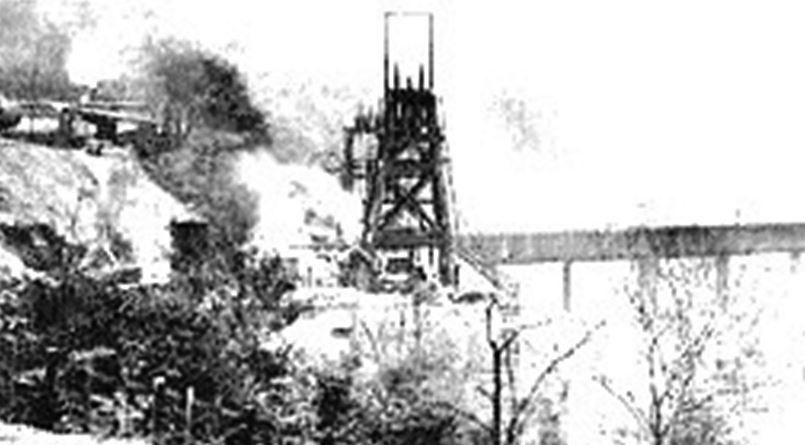Ystalyfera, Swansea Valley (757064)
 This pit was two miles to the north of Pontardawe and was sunk one mile to the south of Varteg Colliery. It was served by the London Midland and Scottish (Midland, Swansea Vale Branch) Railway. The Tareni Nos. 1 and 2 Pits were sunk in 1902/3 one to a depth of 100 yards and the downcast
This pit was two miles to the north of Pontardawe and was sunk one mile to the south of Varteg Colliery. It was served by the London Midland and Scottish (Midland, Swansea Vale Branch) Railway. The Tareni Nos. 1 and 2 Pits were sunk in 1902/3 one to a depth of 100 yards and the downcast
shaft to 150 yards deep due to a geological fault between the two shafts, both were to the Red Vein seam. It worked the Red, Big and Brass anthracite seams by the South Wales Primrose Coal Company.
On the 2nd of November 1909, one of the districts of this pit hit the waterlogged workings of Ynysgeinon Colliery with five miners drowning in the deluge, two of them through electric shocks as the cables were flooded. Another four miners were injured. Those that died were Ben Griffiths aged 18 years, Evan Thomas aged 19, David Edward Rees aged 18, Evan Harris aged 20, Isaac Rees aged 38 years.
On the 25th of June 1913, David John Hopkin, aged 22 years and a collier died when he was run over by trams. On the 12th of August 1914, Thomas Davies, aged 50 years and a collier was suffocated by firedamp.
This Company was not a member of the Monmouthshire and South Wales Coal Owners Association. In 1913/16/19 it employed 630 men producing anthracite coal from the Red Vein seam, with the manager being J. Standidge. In 1923 the manager was Thomas Slater and in 1927 the manager was D.J. Davies. In 1930 the manager was W. Stevenson. In 1915 a new drift was driven to the north-west from the Big Vein to the Brass (Peacock) seam. The Colliery Guardian of the 3rd of August 1928 reported that Tareni was to be auctioned. It had a mineral take of 3,000 acres and was working the Red Vein which had an estimated 25 years of reserves. It was one of the very few anthracite mines outside of the control of the great combines.
The Tareni Colliery Company Limited of Pontardawe was incorporated in November 1928 to take control of the colliery, it had a capital of £50,000 in £1 shares with Henry Mond as the chairman. By 1934 Tareni Colliery employed 100 men on the surface of the mine and 400 men working underground producing 150,000 tons of coal from the Red Vein seam. The manager was W. Stevenson and the company directors were David Owen Evans, Herbert Gibbon and Edgar Pam. The secretary and general manager was Thomas Dixon, while the commercial manager was Thomas Dixon. This was its only mine.
In June 1943, 24 hauliers working at this pit were accused of ‘going-slow’ and were prosecuted by the Ministry of Labour and National Service for breach of the Essential Work Order. They were found guilty and ordered to pay a fine of £20 or be imprisoned for a month. Twenty of them chose to go to prison creating a spate of sympathy strikes in the Swansea and Dulais Valleys even though the men at Tareni had decided in a ballot not to support them.
On Nationalisation in 1947, Tareni Colliery was placed in the National Coal Board’s, South Western Division’s, No.1 (Swansea) Area, and at that time, along with Gleison, employed 96 men working on the surface of the mine and 173 men working underground in the Upper Peacock and Lower Peacock seams. The colliery had its own coal preparation plant (washery) and was managed by A. Hudson. The NCB tried to open up new areas to find workable coal seams at this colliery but they hit geological difficulties and it was soon losing £10,000 a month. This led to the closure of Tareni Colliery on the 4th of February 1949.
Some Statistics:
- 1903: Manpower: 14.
- 1902: Manpower: 715.
- 1907: Manpower: 328.
- 1909: Manpower: 427.
- 1913/9: Manpower:630.
- 1920:Manpower: 650.
- 1922: Manpower: 500.
- 1923: Manpower: 714.
- 1925: Manpower: 680.
- 1927: Manpower: 695.
- 1928: Manpower: 521.
- 1930: Manpower: 509. Output: 140,000 tons.
- 1932: Manpower: 520.
- 1933: Manpower: 503.
- 1937: Manpower: 455.
- 1938: manpower: 375.
- 1940: Manpower: 500 Output: 140,000 tons.
- 1947:Manpower: 269 with Gleison.
- 1948: Manpower: 294. Output: 10,000 tons.
Information supplied by Ray Lawrence and used here with his permission.
Return to previous page
